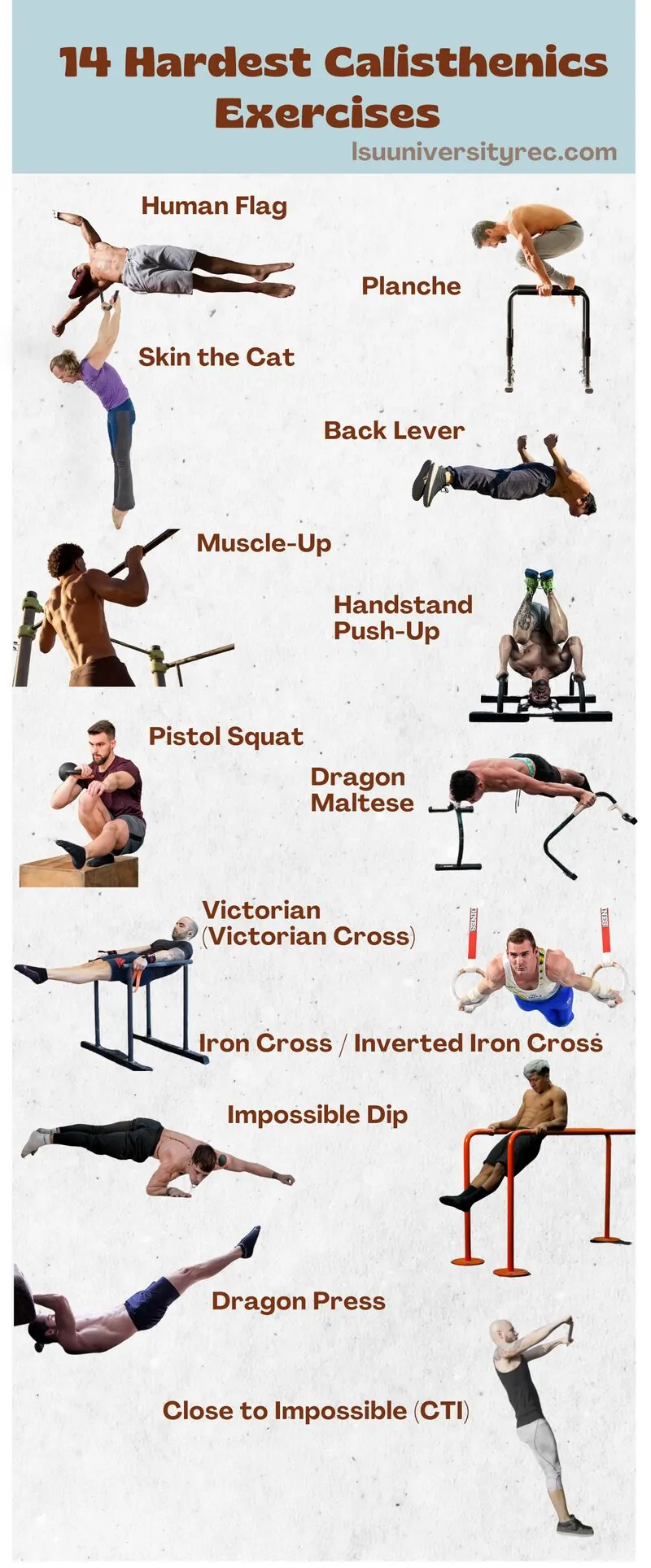
Share Post:
These calisthenics moves require significant strength and coordination, but beginners can achieve them with consistent, focused training.
To avoid injury, it’s important to start with basic calisthenics exercises and gradually increase the difficulty by adjusting leverage or adding weight.
This approach allows for a safe progression to more advanced skills. Here are some examples of challenging isometric calisthenics moves to inspire your training goals.

1. Human Flag
The human flag is a striking calisthenics move, often seen as a show of strength at the beach or park. It demands significant upper body strength, core stability, balance, and body control. Here’s how to perform it:
- Positioning: Start by gripping a pole or similar sturdy surface. Place one hand lower on the pole and the other higher.
- Execution: Push with your bottom arm while pulling with your top arm, extending your body out so it’s parallel to the ground. Keep your legs straight and your core fully engaged.
- Form: Proper form is crucial to prevent injury. Focus on maintaining an even, stronghold while controlling your body position.
The human flag is considered one of the toughest isometric exercises due to the sustained muscle contraction and the intense balance needed.
Technique Tips:
- The bottom arm is used to push, while the top arm pulls to hold the body in position.
- Progressions: To make the move more accessible, try hooking one arm over the pole or practice with different leg variations—such as straddling, tucking, or raising the legs to adjust difficulty.
- Learning Process: A great way to build strength for the full human flag is to begin by positioning your legs parallel to the pole, then slowly lower them until your body reaches a horizontal position. Tucking or straddling the legs can also reduce pressure on your core, making it easier to hold the pose.
2. Planche
The planche is a demanding isometric hold that requires exceptional upper-body strength and balance. Unlike a standard plank, this move involves positioning your hands closer to your hips while keeping your feet completely off the ground, resulting in a powerful full-body suspension.
How to Perform:
- Start by placing your hands firmly on the ground, slightly behind or near your hips.
- Extend your legs straight out behind you, lifting your feet off the ground so your entire body is parallel to the floor.
- Engage your core and shoulder muscles to keep your body steady.
Holding a planche requires the isometric contraction of multiple muscle groups simultaneously, making it one of the more challenging calisthenics moves. The balance needed and the intensity of upper body engagement make it an advanced skill for many athletes.
Progression Tips: Working towards the planche? Try beginning with tuck planches or straddle planches to reduce the leverage demands, which can make balancing easier while building foundational strength.
3. Skin the Cat
“Skin the Cat” is a classic gymnastics movement performed on rings or a pull-up bar. It’s excellent for developing shoulder mobility, upper back strength, and core engagement.
How It’s Done:
- Start by hanging from rings or a bar with your arms straight.
- Pull your legs up and over, moving your hips through your arms, transitioning to an inverted position.
- Continue until your legs extend fully behind you, entering what’s called a “German hang.”
Benefits: This exercise not only builds strength in the shoulders, upper back, and abs but also improves shoulder flexibility. It’s a versatile movement—great for both building strength and warming up the shoulders. “Skin the Cat” can also be used for conditioning when incorporated into high-intensity circuits or repetition sets.
4. Back Lever
The back lever is a dynamic calisthenics move where you hang from a bar or rings with your body extended parallel to the ground, supported entirely by your hands. It’s an impressive demonstration of strength, flexibility, and body control.
Muscles Targeted:
- Primary focus: Shoulders, lats, and core (including the rectus abdominis, obliques, and lower back).
- Supporting muscles: Triceps and posterior deltoids.
For beginners, starting with tuck variations of the back lever can help in building the necessary strength and confidence before extending to a full back lever.
5. Muscle-Up
The muscle-up is a demanding compound movement that combines both a pull-up and a dip, making it a true test of upper body strength, core stability, and coordination. It can be performed on rings, a pull-up bar, or parallel bars, targeting multiple muscle groups—specifically the shoulders, biceps, triceps, back, and chest.
Why It’s Challenging:
- It requires enough pulling strength to lift your body up to bar height and the pushing strength to dip over it.
- The smooth transition from the pull-up phase to the dip phase is where most of the difficulty lies—mastery here demands precision in both technique and timing.
Key Muscles Worked:
- Pulling Phase: Back, biceps, and forearms.
- Transition and Pushing Phase: Chest, triceps, and shoulders.
6. Handstand Push-Up
The handstand push-up is an advanced calisthenics move that requires strong shoulders, chest, triceps, and core stability. It’s essentially a vertical push-up performed while in a handstand position, making it not only a strength challenge but also a test of balance and coordination.
Muscles Targeted:
- Primary: Shoulders (deltoids) and triceps.
- Secondary: Chest and core muscles are heavily involved in stabilizing the body throughout the movement.
Getting Started: To begin learning the handstand push-up, practice with progressions:
- Wall-Assisted Handstands: Start with your feet against a wall to help stabilize while you focus on shoulder strength.
- Assisted Push-Ups: Gradually lower into a push-up while using the wall for support or work with a spotter for extra stability.
- Freestanding Push-Ups: Once comfortable with balance and strength, progress to full, freestanding handstand push-ups.
Tips:
- Wrist Preparation: Warm up thoroughly to prepare your wrists, as they bear significant weight during the handstand.
- Progress Slowly: Balance and strength both take time to build, so mastering control with wall assistance is key before attempting the full, unsupported move.
7. Pistol Squat
The pistol squat, or one-legged squat, is a powerful lower-body exercise that works the quads, glutes, hamstrings, and core. This movement challenges both strength and balance, making it a tough but rewarding addition to your leg workouts.
How to Perform a Pistol Squat:
- Starting Position: Stand on one leg with your opposite leg extended straight out in front of you. Flex the foot of the extended leg to help with balance.
- Descent: Bend the knee of your standing leg to lower yourself slowly towards the ground, keeping your chest up and back straight. Your goal is to bring your hips as close to your heel as possible, while maintaining stability.
- Form Focus: Keep your weight evenly balanced over your standing foot, with your knee tracking over your toes, not inward.
- Return: Once you reach your lowest comfortable position, push through the standing leg to rise back to the starting position.
Progressions:
- Begin with assisted pistol squats by holding onto a pole or using a counterweight like a resistance band for support.
- Box Squats can also help—start by squatting onto a box or bench and gradually lower the height as your strength and control improve.
8. Dragon Maltese
For those seeking a step beyond the already formidable Maltese, the Dragon Maltese presents the ultimate challenge. This advanced variation starts in the Maltese position, typically performed on parallettes, but adds an additional twist that takes it to an even greater level of difficulty.
The Dragon Maltese Technique:
- Start by positioning yourself in a standard Maltese on parallettes, with your body held straight and parallel to the floor, supported only by your hands.
- The Twist: Unlike the normal Maltese where you grip the handles of the parallettes, the Dragon Maltese requires holding the legs of the parallettes with your thumbs pointing down. This unique grip, a contribution by Yordan Stanchev, significantly increases the difficulty and control required.
Why It’s Hard:
- The grip variation makes the exercise even more demanding, as it changes the leverage and increases the load on your shoulders and chest.
- It requires extraordinary levels of full-body tension and shoulder strength to maintain stability in this position.
9. Victorian (Victorian Cross)
The Victorian is a challenging static skill that originated in 19th-century gymnastics and remains one of the toughest calisthenics moves. Essentially a reverse Maltese or reverse Planche, it involves hanging in a horizontal, floating position between parallel bars, with the arms kept straight beside the body.
Difficulty:
- The hardest version is performed on parallel bars, requiring incredible forearm strength along with full-body tension.
- Before attempting the Victorian, athletes must first master the Front Lever and build significant strength on a single horizontal dip bar.
10. Iron Cross / Inverted Iron Cross
The Iron Cross, a classic gymnastics move, is now a staple in advanced calisthenics. It is performed on gymnastic rings by extending the arms straight out to the sides, while keeping the body straight and vertical. Though it may look simple, it is one of the hardest ring exercises, requiring immense shoulder strength and stability.
Technique:
- Iron Cross: With shoulders at a 90-degree angle, your bodyweight is suspended at full arm extension, maximizing gravitational forces.
- Variations:
- L Cross: Combine an L-sit with the Iron Cross position.
- Inverted Iron Cross: Perform the movement upside down, adding another level of complexity.
11. Impossible Dip
The Impossible Dip is an advanced variation of a dip performed on parallel bars. The movement involves leaning back while pushing your hips past your hands, placing extreme tension on the triceps and shoulders.
Why It’s Hard:
- Positioning: The backward lean shifts the leverage, demanding intense triceps engagement and making it exceptionally challenging.
- Strength and Safety: While not highly technical, the strength required is significant, particularly in the triceps. It also places considerable stress on the elbows, meaning a slow, careful progression is crucial to avoid injury.
12. One-Arm Planche
The One-Arm Planche is the ultimate progression after mastering the regular Planche. This move involves holding a Planche position with just one arm, requiring incredible balance and strength. The supporting arm is fully extended, blending the extreme difficulty of both a One-Arm Handstand and a regular Planche.
Why It’s So Challenging:
- It requires full-body strength, especially in the core, shoulders, and arm.
- Balancing on a single arm in a horizontal position makes it a contender for one of the hardest exercises in calisthenics.
13. Dragon Press
The Dragon Press is an underrated yet extremely challenging exercise, which might explain its lack of popularity. It involves lying flat on your back, then lifting both your shoulders and lower body until only the upper back remains in contact with the floor. You use your fingertips, placed beside your hips, to press down for minimal support.
Why It’s So Tough:
- Despite its seemingly simple form, most people can barely hold this position, if at all, for more than a second or two due to the intense core and stabilization requirements.
- It demands strength throughout the entire body, especially in the core, shoulders, and lower back.
Though often overlooked due to its deceptive appearance, the Dragon Press is a valuable supplementary exercise, particularly for those training towards advanced skills like the Victorian Cross or Front Lever.
14. Close to Impossible (CTI)
Why It’s Impossible:
- The main issue lies in the massive torque created by the position, due to the distance between your body’s center of mass and the bar.
- With your arms fully extended, the force generated on your hands is far beyond what human muscle and grip strength can handle. For example, someone weighing 70 kg (154 lbs) would experience approximately 700 Nm of torque, which would exceed the strength capacity of the muscles, tendons, and grip required to hold the position.
Even though the idea of this technique may intrigue some, physics makes it literally impossible to perform without catastrophic damage to your body. While it’s an interesting theoretical exercise, the Close to Impossible truly lives up to its name.
Related Posts:
- 16 Hardest College Majors in 2024 (By GPA and Other Factors)
- What is Quizlet and How to Use it to Create…
- How Group Exercise Can Boost Your Motivation and Results
- 8 Good Online Math Tutoring Websites for Kids and Students
- Top 10 Benefits of the Bodyweight Mastery Program…
- Intramural Sports - What They Are and How They Work










